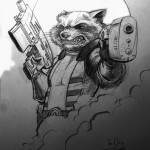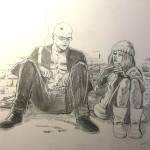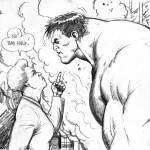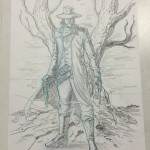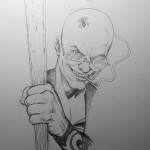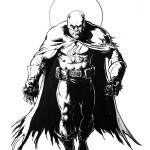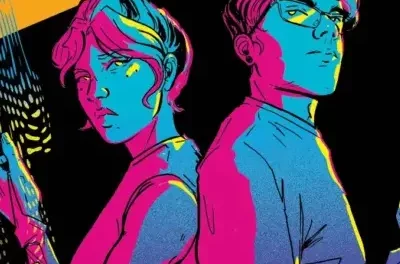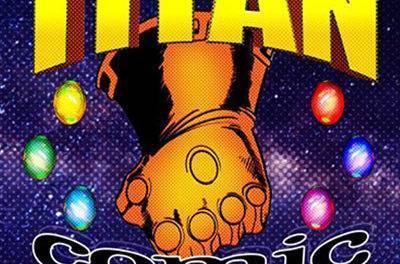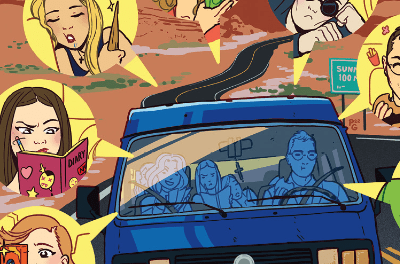 Darick Robertson is an industry giant and has been working in the comics industry for 30 years. He is best known for his work on Transmetropolitan, The Boys, and The Punisher. This past fall we met at Cincy ComicCon and were able to connect to talk about his career, cons in general, and what he is working on now.
Darick Robertson is an industry giant and has been working in the comics industry for 30 years. He is best known for his work on Transmetropolitan, The Boys, and The Punisher. This past fall we met at Cincy ComicCon and were able to connect to talk about his career, cons in general, and what he is working on now.
Ryan Mount: How was your experience at Cincy ComicCon? I’m originally from the east coast and I really enjoy Cincy ComicCon because it is a creator and comic fan focused show.
Darick Robertson: I really enjoyed my time in Cincinnati. Con organizer/owner and old friend Tony Moore and his fantastic wife Kara were wonderful hosts! The show was well attended and well organized. It was refreshing to see comic artists and writers were the focus of the guest list as so many ‘comic’ cons don’t even put comic art or creators on their posters anymore. They are all about Sci-Fi actors that play characters as those faces are recognizable and a big draw for the average fan. Sad really, as comics are where it all started and even now the name “ComicCon” is almost ironic, as comics and their creators are relatively anonymous.
RM: You have had a long, prolific career, working for many comic publishers including Marvel, Image, DC, Dynamite, and many more. What do you think has attributed to your success in working with that many publishers?
DR: I’ve been working in the industry most of my life, 30 years this year, having been first published just out of High School when I was 17. The comics industry has a lot of talented people that move about from company to company and often, they want to work with people whose work they know and can be depended upon to meet deadlines, be professional, etc. I suppose in that regard I’ve been fortunate that people like my work and like working with me enough to bring me aboard for new projects. I like diversity in the industry, so I’ve made an effort to expand to new publishers and indie projects as a way of opening up possibilities for different homes for projects in the future that I want to do. Finding the right publisher for the right project is important.
RM: With your work across so many publishers, fans were treated to your variant cover of Archie vs Predator this past year. So, when is your Archie book coming?
DR: As soon as I have a schedule opening and they want me. My friend Roberto Aguirre-Sacasa is Chief Creative Officer over there, and I had a great time working on Nightcrawler with him back at Marvel, so really it’s just a matter of scheduling time, hopefully.
I’m so booked right now, new projects are still a ways off, but I am excited by what has changed over at Archie. Their success is a prime example of making something classic, fresh and important again by thinking in new directions and taking creative chances. And that cover was so much fun to draw!
RM: Going back a little bit, when we met, I mentioned a big spot in my comic-heart for your work on The Boys. It was one of the few indulgences I allowed myself as a broke intern living in the Middle East at the time. You seem surprised that I was picking up that title over there. We know you have a huge fan base here in the States and in the U.K., but have you ever been surprised about your success in other markets outside the major ones? Or have you ever been shocked to hear that someone who lives outside those major markets was such a big fan of your work?
DR: The Boys is such raw nerve, so offensive at times, that it surprised me that it was published in the Middle East. I heard that a woman in a small town in England found it in her local library and got very upset that the comic even existed. So much so, that she pulled every copy out of library without the consent of the library itself, for fear anyone would read them, especially children, who she seemed to think the comics were aimed at, just because they were comics! Many people still don’t seem to realize that now, more adults read comics than kids do.
It’s always a little strange to me, to create something so privately and personally and realize it has been translated and published all over the world. The artwork I create starts in my brain, in seclusion and then travels so far into the world outside of my relatively simple and humble day to day life, it’s hard to imagine anything other than the story I’m telling, much less it’s potential impact. I’m better off just staying focused on the work itself. Imagining a reader as far away from me as the Middle East just seems surreal, but I’m grateful that work has had an impact and found such a large audience, as I think the book has something to say about power and influence, and media creating illusions for the masses. I believe The Boys is deeper than it appears on its surface.
RM: You certainly have had long runs with Transmetropolitan and The Boys… Lately your focus seems to be mini-series. Do you take a different approach when telling an ongoing over something shorter?
DR: Well, I don’t know now if I have another monthly ongoing series in me. They require a lot of time and focus. In some ways, The Boys was my last shot at an ongoing and I had to struggle to keep up with the schedule. There were a lot of factors, but in the end I started to burn out on just getting the work finished, as opposed to creating work that I felt was the best it could be, and having to ramp up for another issue with no down time as soon as I finished one. That’s the business end of things, and publishing is about hitting deadlines.
However, I’m at a stage in my life where I want to be creating better work, as your work becomes your legacy. You can churn out stuff that’s good enough, or focus on creating work that is as good as it can be. Smaller stints and shorter commitments, longer, more open schedules, create windows of opportunity to get more ideas and original work out into the world, and creating new stuff is more of what I wish to do with my time now. I enjoyed working on Transmetropolitan back in the day, but I was a younger man, without children to raise and I was moving and traveling. My lifestyle allowed me to draw that book whenever and wherever I was, and that frenetic energy shows in those pages. Also having the great creative team of Rodney Ramos, Nathan Eyering and Clem Robbins to hit those deadlines too, which made that book what it is. We went through so many editors, that it’s remarkable that after issue 5, our whole creative team stayed together for the next 55 issues.
RM: We know that there had been talks to bring Transmetropolitan to the big screen, but it never materialized. Now, with the success of comics into television (The Walking Dead) and film (Marvel), which work of yours would you like to see make its way onto the screen and why?
DR: I would love to see them all make the jump. Transmetropolitan is near and dear to my heart, so I hope that if it ever gets made, that it’s made faithfully with the humor and insight that Warren Ellis brought with those stories we told and the characters we created.
RM: You received a lot of acclaim for Ballistic over at Black Mask. Outside of your creation, they have been putting out some really high quality books like We Can Never Go Home and Space Riders. What is it like working over there?
DR: Ballistic was one of their first titles, and I completed that a couple of years ago. I’m not currently doing any projects for Black Mask. Matt Pizzolo is the energy behind that company and he passionately believes in their books, so working with him and my friend Adam Mortimer was terrific. Challenging at times, as we were really in a lot of uncharted territory, being that Black Mask was so new. Adam and I had absolute freedom to tell the story that we wanted to tell, but not really sure where it was going to hit. It was strange to do a book that was so well received, but so few people seem to even know that I did that project. I still think that it’s a book that will appeal to any Transmetropolitan fan. The collection turned out beautifully, with Sonia Harris’ excellent graphic design. I hope more people discover it now that it’s collected. It’s a book I’m very proud of.
RM: Vertigo just released the collection of Strange Sports Stories which you were a contributor. You seemed like a perfect fit for your story “Leap of Faith” which saw the future in a bleak state. How did that project come to be? And anything else you would like to say about that project?
DR: Honestly, it was just a fun opportunity to finally work with Will Dennis, the editor and an old friend, as he was leaving Vertigo shortly after that project wrapped up, with DC moving their operations from New York to Burbank. The writer is my good friend Ben McCool, who reached out to me and asked if I was into drawing it.
I really like working with people with whom I get along with personally, and have a rapport with outside of the work, so creating with Ben was a joy. Ben’s talented and has a great wit, so that story reminded me a bit of what was fun about Transmetropolitan; creating a crazy sports game in a weird future. Richard Clark was up for inking it, and did a great job, so it was an chance for me to work with an excellent group of creators, with all of us having creative fun on a short story.
RM: Back in 2012, you announced Oliver to be published by Image Comics. What is the current state of the project?
DR: I had to compromise my time as it’s a project, that as I began drawing it, became clear to me that with the level of detail that I’m putting into Oliver, it was not something I could put out on a monthly schedule. So I discussed it with Eric Stephenson and Gary Whitta, and we agreed it was better to create at my own comfortable pace, create the book that I want it to be and we’ll release it when it’s ready. I don’t want to put out a book that disappears from the shelves after a few issues because I can’t keep up the schedule. I am hopeful that will be released this year, as that’s my goal that I am working towards at the moment, and that it will be worth the wait. I do feel it’s the best work of my career at this point and Gary Whitta is an excellent collaborator and partner.
RM: What are you working on these days? Any bucket list story to tell?
DR: Well, Oliver, as stated in the previous answer, and a book my partners Eric Peterson, Joe Aubrey and I previewed at San Diego Comicon last summer, Tooth and Mail, which is an indie project that was funded originally by a Kickstarter campaign. I’ve taken the last couple of years to work slowly and reset myself for future projects. I have a lot of seeds l’ve planted and I hope to be announcing new things to come in the next year or so…. I have some stories that are still burning me up to write and draw, but I also have a long list of collaborators whom I am eager to work with as I complete my current slate of projects. It’s a challenge for me, as the temptation to write my own stores is at odds with collaborating with people that are so much fun to work with.
RM: Thank you for your time Darick. You were great.
It was a great interview and I encourage everyone to pick up some of Darick Robertson’s work. You can follow him at @DarickR on twitter and go to his website at www.darickrobertson.com. You can also check below for some of his favorite con sketches that he sent to be published with this interview.
—————–
You can follow Ryan Mount @hebruise on Twitter and look for more upcoming interviews and comic rants here at twoheadednerd.wpengine.com.

